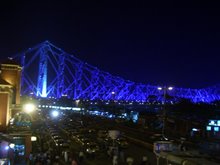How good are your light bulbs? Are they actually increasing
the size of your air-conditioning bills? And should we switch to CFL and stop
using the good old incandescent bulb?
The electrical energy that is used by light bulbs is
converted into about three different kinds of energy. They are light energy,
heat energy and sound energy.
Light energy is what we want, so let’s focus on the other
two.
Bulbs emit sound energy. They do. Do you ever listen to your
lights? ‘Lights’ includes the fixture, ballast or electronics package, if any,
along with the bulb. Haven’t you heard the humming of a tube light?
Yes, sound from light bulbs is wasted energy.
When you hear a light that is making sounds, you are hearing
wasted energy. The buzzing, humming or whirring noise from lighting equipment
is not light energy. It is escaping sound energy.
Luckily, the energy wasted from lighting as sound energy is
very small, and doesn’t really pinch our pockets.
Now, most of India is dealing with a scorching summer. Well
your light bulbs can actually add to the heat of your room. Heat is not light.
Unless you want it, heat is wasted energy.
Energy wasted as heat from lights is a big deal. The really
big waste of energy from lighting is heat.
Old fashioned tungsten light bulbs are very efficient
heaters. These incandescent light bulbs convert about 95% of the electricity
they use into heat. In today’s terms: Big carbon foot print but little light.
Those of us who are in the cold regions of the north-east
India or the Himalayas, where water can freeze in winter often keep a light
bulb inside a water-pump shed to keep the water flowing through the pipes.
60 to 100 watt bulbs make excellent heat and light
arrangements for aquariums in winter. If you need a space heater, in an
emergency, plug in as many old light bulbs as you can.
However, when 95% of the electrical energy is converted to
heat energy, it leaves only 5% that is converted into light energy. And that’s
why these lights aren’t such a good idea in the hot summers of the Indian
plains.
The next group of light bulbs are the 80% heaters. Light
bulbs that operate at very high temperatures are about 80% or more efficient as
heaters. They include:
Halogen lights like the headlights on cars. HID lamps (High
Intensity Discharge) used in street lamps.Mercury vapour lights, used by some
people to light up their gardens .
These light bulbs put out a lot of light. To do it they
operate at very high temperatures. They are OK to use outdoors or in big
buildings but not so safe inside homes.
When they convert about 80% of electrical energy into heat,
it leaves only 20% that is converted into light. These are better than the
incandescent bulbs but still not wonderful. They save money only because they
last a lot longer than incandescent bulbs.
LED light Bulbs are about 82% heaters. This may come as a
surprise, but electricity expert and blogger Birney Summers says that LED light bulbs convert about 82% of
the electrical energy into heat. They don’t get very hot because they are
designed to cool quickly.
The long life of LED lights depends on keeping them cool.
The electronics package hidden in the base of the bulb will melt if it gets too hot. That is why you can’t use LED
lights in your oven. They would last a very long time as the light in a
refrigerator.
LED lights convert 18% energy into light. They convert 82%
of electrical energy into heat. The good thing about LED bulbs is they give a
lot of light for a small amount of power and last a long time.
The other good thing about LEDs is they do not contain
mercury.
So what kind of light bulbs are cool?
Fluorescents convert about only 30 to 50% of the electrical
energy they use into heat. Did you ever try to keep warm by huddling around a
fluorescent light? I didn’t think so. Because they are such poor heaters, they
save money on electrical bills in two ways.
First, they put out the most light for the electricity used.
This is why Compact Fluorescent Lamps (CFL) are so popular for home use.
Second, because they don’t create as much heat they also
reduce air conditioning bills. The heat from lighting is part of the heat load
that your AC works hard to remove from the building. Less heat load means lower
air-conditioning cost.
Some clever people use incandescent bulbs at home in the
winter, when heat is a good thing. Then they switch to CFL bulbs in the summer
when heat is not wanted.
Their bulb switch plan is good because it exercises wrist
muscles with all that twisting in and out of light bulbs. It is also good
because you wipe away the dust that blocks some of the light from your bulbs
twice a year.
Fluorescent lights are good because of their small carbon
footprint, but they do contain trace amounts of mercury. Pick your poison. The
amount of mercury in fluorescent bulbs has been minimized as they have evolved
over the years, but it is still in them.
So now you know about lights and AC bills. And please
remember that the old fashioned ‘Thomas Edison’ type lights are pretty useful in cold climates.


